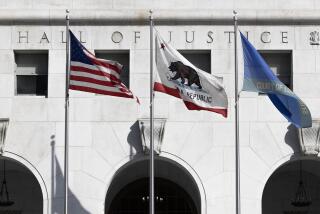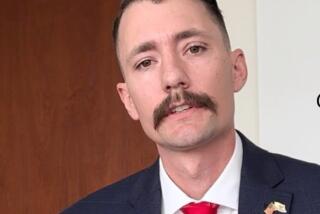Violent South Carolina classroom arrest adds to ‘school-to-prison pipeline’ debate
It happens so often in classrooms that it’s almost unremarkable. A student sends a text during class, plays a video game on an iPad or mouths off, drawing a reprimand from the teacher.
Then what?
At Spring Valley High School in Columbia, S.C., a similar scenario ended Monday when a white sheriff’s deputy — summoned after an African American student refused to leave the class — yanked the student from her desk and threw her across the floor.
UPDATE: Deputy who threw South Carolina student from her desk is fired
The FBI on Tuesday launched a federal civil rights investigation into whether Richland County Senior Deputy Ben Fields, who was suspended without pay, broke any laws during the fracas inside a math class.
But the encounter also has many questioning why a police officer was needed in the first place.
I think sometimes our officers are put in uncomfortable positions when a teacher can’t control a student. We don’t need to arrest these students. We need to keep them in school.
— Leon Lott, sheriff in Richland County, S.C.
Since the 1990s, educators and parents have demanded “zero tolerance” policies in response to school shootings, drugs and gang tensions. Creating safe schools became a mantra for elected school boards. One result has been the deployment of an estimated 14,000 officers on campuses across the country, a number of them carrying weapons, and a number of them now tasked with duties that go well beyond holding shooters and gangsters at bay.
In many districts across the country, common discipline problems that were once the purview of teachers and school administrators are being handed off to armed police officers. And infractions that once resulted in detention may now leave students with criminal records — a phenomenon that critics say disproportionately affects African American students.
The girl in the South Carolina incident, captured on other students’ cellphone videos, faces a misdemeanor charge under South Carolina’s “disturbing school” law.
NEWSLETTER: Get the day’s top headlines from Times Editor Davan Maharaj >>
“What we find is school safety becomes conflated with school discipline — officers dealing with classroom disruptions, dress code infractions, minor discipline infractions that in the past would have been handled by teachers,” said Janel George, a senior education policy counsel at the NAACP Legal Defense and Educational Fund.
In recent years, advocates have decried the “school-to-prison” pipeline created by the rise of no-tolerance policies at schools.
In the 2011-12 school year, black students represented about 16% of the student population, but accounted for 27% of all student referrals to law enforcement, and 31% of school-related arrests, according to a federal report from the Department of Education’s Office for Civil Rights.
The statistics were so alarming that last year Los Angeles Unified School District police stopped giving citations for fighting, petty theft and other minor offenses in response to growing research showing that when police handle such matters, struggling students are more apt to drop out and get in more serious trouble with the law.

There are no national standards for training school police, according to Mo Canady, executive director of the National Assn. of School Resource Officers, the name typically given to school police. School districts have stepped up the police presence on campus to “bridge the gap between police officers and youth.” When officers are well trained and work closely with school officials, arrests in schools go down rather than up, he said.
The Richland County Sheriff’s Department says school resource officers have three roles: serve as deputies, provide a positive role model and counsel students with problems.
“It takes such a unique officer to do this job,” said Canady, whose organization trains school officers. “Kids are going to say things you’re not going to like, they’re probably going to make you mad, but there’s a certain part of that that’s just adolescence.”
But training is just a fraction of the challenge. School police also must act on the tricky line between criminal action and school rules, which are set by local policy and state laws, Canady said.
Although Richland County Sheriff Leon Lott has 87 deputies stationed at schools, including Fields, even he expressed discomfort with the idea of deputies getting involved in classroom discipline problems.
Lott noted South Carolina’s disturbing-school law makes it a misdemeanor “to interfere with or to disturb in any way or in any place the students or teachers of any school or college in this state,” which could apply to a broad range of behavior.
“I think sometimes our officers are put in uncomfortable positions when a teacher can’t control a student,” Lott said. “We don’t need to arrest these students. We need to keep them in school.”
Lott said his office would also look at when it is proper to call in a resource officer. But “that is something for the district to answer,” Lott said. “Is it proper to call in a resource officer to discipline a student, or is that the job of the school?”
At least three students who were in the classroom at Spring Valley High said the teacher tried to discipline the unidentified student for looking at her phone.
When the student refused to leave class, the teacher called in a vice principal. When the student refused the vice principal’s request to leave, officials called in the deputy, Fields, who also helps coach the school’s football team.
In one video, the deputy can be seen telling the student sitting at her desk, “You either come with me, or I’m going to make you.”
In a second video posted on Instagram, the student can be seen lifting her arm defensively as the deputy physically tries to remove her from her desk.
The deputy then wraps his arm around her neck from behind in a headlock and tries to lift the student by one of her legs. As the deputy struggles with the student, the desk flips backward onto the ground with the student still sitting in it, the video shows.
The desk then crashes into another desk and nearly hits another student, who appears to be shocked at what she is witnessing. The deputy drags the first student, who is still entangled in the desk, and throws her across the classroom, the two videos show.
Lott said there was a third video that showed the student hitting the deputy.
The girl was not injured, Lott said, and was released to her parents.
“This is a perfect example of how the school-to-prison pipeline plays out in everyday life,” said Michael Harris, senior juvenile justice attorney for the National Center for Youth Law, an advocacy nonprofit. “A student does something that’s minor, not that threatening, not putting anyone else in danger.
“Many schools over the last, I would say, two decades have shifted how they deal with student misbehavior,” Harris said. “And that shift really involves having law enforcement be the major component in enforcing school rules.”
A teacher in a similar situation could have prevented it from escalating in several ways, according to Daniel Losen, director of the Center for Civil Rights Remedies at UCLA’s Civil Rights Project and an author of a report that came out this year on school discipline in the U.S.
The teacher could have waited until the end of class to deal with the student or could have brought in a counselor trained in de-escalation, Losen said.
“In no case would I put as a choice ‘calling a police officer and having the student arrested,’” Losen said. “That doesn’t make any sense.”
Although Monday’s incident was concerning, “we don’t find this exceptional,” said George of the NAACP defense fund.
“What happened yesterday happens so often in our public schools,” George said, adding of African American students: “These are spaces where they should feel safe. They’re feeling profiled; they’re feeling criminalized.”
Times staff writers Michael Muskal and Teresa Watanabe contributed to this report.
ALSO
Ambushes of police are rising again at a difficult time for law enforcement
Hot dogs, bacon and other processed meats increase risk of cancer, scientists say
Northrop’s deal to build new stealth bomber may create thousands of jobs in Southland
More to Read
Sign up for Essential California
The most important California stories and recommendations in your inbox every morning.
You may occasionally receive promotional content from the Los Angeles Times.












